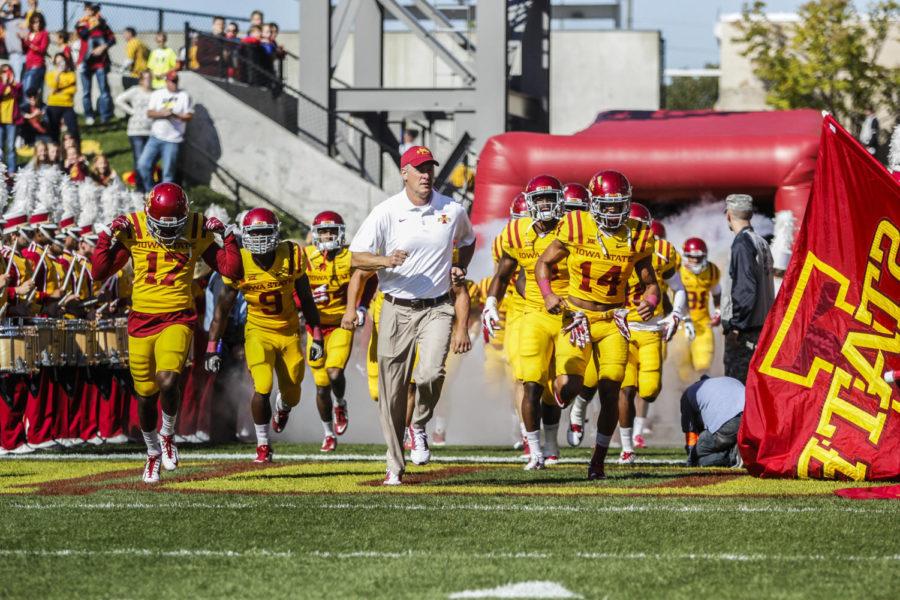Notebook: Rhoads talks Big 12 format, injuries
Coach Paul Rhoads and the Iowa State football team run onto the field before the Homecoming game against Toledo on Oct. 11 at Jack Trice Stadium. The Cyclones defeated the Rockets 37-30.
April 22, 2015
The state of the conference
Only 10 teams comprise the Big 12 membership, which is the lowest total among the power five conferences [Big 10, SEC, ACC and Pac 12] and is highlighted by two meaningful implications.
The first is that every team plays every other team in a true round-robin, regular season format. The second is that no conference championship game is allowed because current NCAA regulations require at least 12 member schools for a title game to exist.
“I’ve always been a proponent for the round-robin format and playing everybody in your league,” said ISU coach Paul Rhoads. “I’m very comfortable with the league and how it’s set up, and it certainly makes it very challenging and competitive.”
Rhoads extended his comfort level to include the absence of a conference title game.
“The fact that we play everybody, the league has worked hard to put some tie-breaking formulas into place … and be able to declare who our champion is,” Rhoads said. “It’s tough enough to beat a team once, and the fact that you play everybody once, you’ve hopefully settled it on the field.”
The winds of change could do some good
Yet it must be noted that Rhoads is the captain of a team that has recorded only five victories during the previous two seasons. The larger implications of a championship game that disappeared during conference realignment have little bearing on how Iowa State’s seasons have ultimately panned out. Not every Big 12 team can say the same.
Baylor and Texas Christian [TCU] were both one-loss programs after the regular season ended in 2014, and heading into championship week, both teams were slated above Ohio State in the rankings for the first ever College Football Playoff.
After Ohio State routed Wisconsin 59-0 in the Big 10 title game, the one-loss Buckeyes surpassed the Bears and leaped over the Horned Frogs into the fourth and final spot. Ohio State sported a record that featured the same number of losses as both Baylor and TCU, but boasted one more win, which came immediately before the playoff committee’s decision.
The Buckeyes followed their side-stepping act into the postseason by riding their momentum all the way to an improbable national title, defeating the SEC and Pac 12 champions along the way.
A great deal of speculation followed as to what role a conference title game, or lack there of, may have played in the final playoff seedings. Rhoads said until more is known about the selection process, however, his opinion isn’t likely to be altered. But that doesn’t mean the current Big 12 paradigm can’t or won’t change, or that said changes may not arrive quickly.
“I’m sure it will be a piece of discussion for us in our conference meetings in the month of May,” Rhoads said. “I think what will be very telling in that is if there’s more that comes out of the playoff committee’s communication to the other schools that yeah, a championship game is important and it will weigh heavily on where we rank teams to end it all.”
Injury news
The Cyclones have suffered a number of injuries this spring, which Rhoads alluded to as being reflective of the last number of years of ISU football.
“I don’t think we’ve ever had a defeatist attitude amongst our team,” Rhoads said. “I think we’ve had an injured reality amongst our team in that we’ve been badly decimated by injuries, and in a league as challenging as the Big 12 if you’re not playing with your best, it’s even harder.”
Perhaps the biggest injury concerns in 2015 revolve around linebacker Luke Knott’s hip, but the questions aren’t soon to be answered.
“They’re going to perform a procedure to try to alleviate some pain he’s going through and then it’ll be a matter of time to see how that works,” Rhoads said. “I don’t really believe I’ll have any kind of concrete answer for you on that until August gets here because I think they’re going to give him that kind of time frame to really see how [his injury] responds this next batch of treatments.”
Rhoads added the only other new and relevant injury news involves backup running back Justin Webster, who will be out for the majority of the 2015 season — if not all of it — due to an ACL tear.







